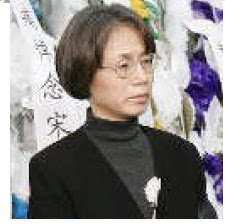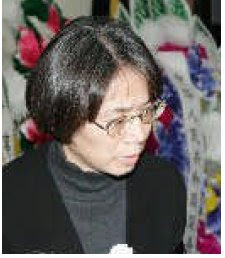

This is the iconic photograph of Song Binbin (宋彬彬) pinning a Red Guard armband onto Mao Zedong in 1966, marking the official beginning of the Cultural Revolution. The photo and caption are reprinted from MacFarquhar's and Schoenhals Mao's Last Revolution.
Above right is the photograph of Song used in Carma Hinton's propaganda film Morning Sun, and above left is a 2005 photograph of Song taken at the memorial service in Beijing for her father.
To our knowledge this is the first time that a current photograph of Song has appeared in any English language publication in America, where Song lived until recently retiring to Beijing.
Song's father was a Chinese Communist Party official. In 1966, she was 19 and a student at the elite Girls Middle School attached to Beijing Normal University.
Mao started the Cultural Revolution in secrecy in the spring of 1966. Violence followed. That summer while Mao was away from Beijing plotting, his uninformed head of state, Liu Shaoqi, attempted to control the violence without stopping it in a way that he hoped Mao would approve. Liu sent in "work teams" to the various middle (high) schools and universities around Beijing. Bian Zhongyun, the vice principal of the Girls Middle School, was denounced and "struggled" (beaten) on June 23.
On August 1, Mao made a triumphal return to Beijing. Immediately he ordered the removal of the work teams, thus turning over control of the schools, and the violence, to the students. Mao's order also was the beginning of the swift purge of Liu Shaoqi. Violence increased.
In "Red August" and September of that year over 1700 innocent people were murdered in torturous ways. Song Binbin, one of the most prominent Red Guards in Beijing at the time, was the head of the in-charge Revolutionary Committee at the Girls Middle School where Bian was vice principal. On Song's watch Bian was beaten again on August 4.
In the afternoon of August 5 Bian was paraded out of the school by Song's Red Guards. This is how two leading historians describe what happened next:
"The headmistress [Bian], a fifty-
year-old mother of four, was
kicked and trampled by the girls,
and boiling water was poured
over her. She was ordered to
carry heavy bricks back and
forth; as she stumbled past, she
was thrashed with leather army
belts with brass buckles, and with
wooden sticks studded with nails.
She soon collapsed and died." (1)
Bian's body was placed in a garbage container and deposited in front of a hospital right across the street from the school.
Bian's murder is the most notorious of that time first, because it was the first instance in Beijing of a teacher being murdered by her students; second, because of the torture; third, because all of the murderers were girls and fourth, because the girls who attended the school were the best and brightest of Beijing with many coming from the elite families of the C.C.P. (2)
In her capacity as head of the committee in charge of the school Song Binbin went to Beijing deputy mayor Wu De to officially inform him of Bian's murder.
Thirteen days after Bian's murder Mao made a dramatic predawn appearance in Tienanmen Square. The occasion was the first rally of the Red Guards. Over one million were in attendance. Up on the reviewing stand Red Guard leaders were given the honor of appearing with Mao. Some Red Guards pinned armbands on government officials, including Mao himself:
"A leading perpetrator of the
atrocities in the girls' school
where the headmistress had
just been killed was given
the signal honor of putting
a Red Guard armband on
Mao. The dialogue that fol-
lowed was made public:
'Chairman Mao asked her:
"What's your name?" She
said "Song Binbin."
'Chairman Mao asked: "Is
it the 'Bin' as in "Educated
and Gentle?" She said:
"Yes." Chairman Mao said:
"Be violent!' " (3)
The photograph above records that moment. It represented Mao's symbolic approval of Red Guard violence and the official start of the Cultural Revolution which was to last ten years and claim an estimated 3,000,000 lives.
Song Binbin changed her name to Song Yaowu, "Be Violent." Her school was renamed the "Red Be Violent" school too.
On August 20 an article in People's Daily appeared signed by Song Yaowu describing her ecstatic experience with Mao.
Song immigrated to the United States in 1980. She got her Ph.D from the Massachusetts Institute of Technology in 1989 under the name of "Yan Song" and for some time thereafter worked for the Commonwealth of Massachusetts as an environmental researcher. She and her husband lived first in Lexington and then Concord, Massachusetts. Their son currently attends Stanford University.
To this day Yan Song, aka Song Yaowu, nee Song Binbin has refused to be questioned about the subject. Song and her friends, Carma Hinton,(4) and fellow Red Guard Weili Ye and others have gone to great lengths to defend her and to protect even her true identity.
Below is another picture of Song taken at her father's memorial as well as a third taken at a party. (5)
The publication of these photographs represents a small crack in China's Great Wall of Silence. This is Public Occurrences.
Anyone with information on the
identities of those involved in
the torture and murder of Bian
Zhongyun, contact us at
(1) Mao, The Unknown Story. Jung Chang and Jon Halliday, p. 506
(2) Among those were the daughters of Liu Shaoqi and Deng Xiao-ping.
(3) Chang and Halliday, p.506.
(4) See Carma Hinton's "Interview" of Song Binbin" below, March 19, 2007.
(5) The party photo is from the blog of a young Chinese photographer. The blog can be found at blog.daqi.com/baokun/


(First published May 4, 2007)














